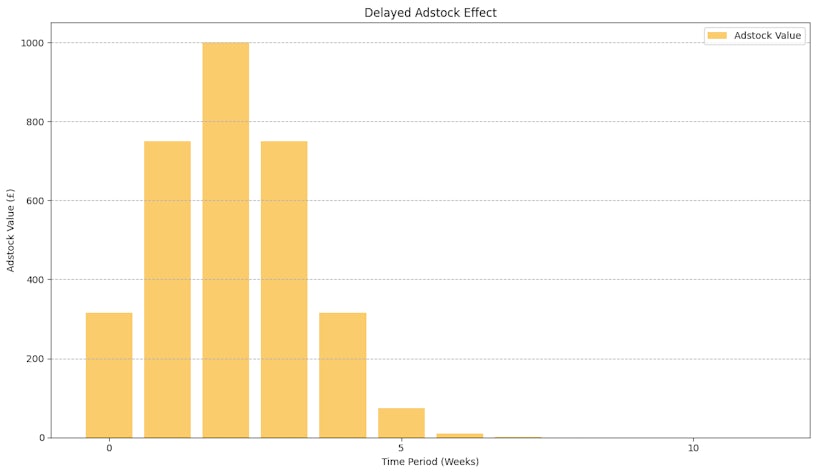One of the most overlooked phenomena in marketing is the adstock effect. The adstock effect describes the lingering or delayed impacts of advertising, where marketing efforts hold “stock” in the mind of consumers for weeks on end. Neglecting this dynamic could lead to potentially halting campaigns which are in fact leaving a lasting effect on the consumer, forfeiting long-term incremental gains.
For example, the impact of a TV advert is likely to have a lasting influence weeks after it is shown, however a Google Search ad is likely to be forgotten about soon after it is seen, therefore having less of a long term effect.
What exactly is the Adstock Effect?
At its core, the adstock is just a transformation based on a decay model. The transformation captures how much of an advertising campaign’s impact persists from one week to the next. The most critical variable is the decay rate, which determines the speed of the decline. A high decay rate means the effect lasts longer, while a low decay rate indicates a quick drop-off.
The graph below titled “Geometric Adstock Effect” illustrates the most common concept of adstock. The Geometric Adstock assumes a constant decay of the spend/impressions over time. In this example, with a single £1,000 spend in the first week, the adstock value immediately peaks at £1,000. Since, in this case, there is no new spend in subsequent weeks, the graph is a pure decay curve. The ad’s effect diminishes at a fixed rate each week, representing the carryover. This illustrates the long-lasting but gradually fading impact of a single advertising campaign.
Limits are set on adstock, otherwise the effect would carry on forever. This limit can vary depending on the type of business, but a recommended limit is around 12 weeks.

In this example, α is set at 0.7, meaning the adstock the following week is 70% of the adstock the week before.
The formula for the geometric adstock effect is given here:

Where At is the Adstock in week t, Xt is the ad spend/sessions on week t, and ɑ is the decay rate, and is between 0 and 1. A0 = X0 in all cases, meaning the adstock of the initial week is equal to the spend/sessions in the initial week.
At is essentially the “effective spend” on week t (in the context of ad spend). In other words, the adstock in a particular week is equal to the spend that week plus the adstock from the previous week multiplied by the decay rate.
The geometric adstock is the most widely used adstock transformation, because it assumes that the peak of its effectiveness comes at the point of exposure to marketing activity. In some cases, it is unwise to model the effect like this (this is discussed later).
For Marketing Mix Modelling (MMM), the adstock transform is vital. It estimates the true, lasting impact of advertising per channel. This is particularly important because MMM is typically conducted with weekly data, meaning a significant portion of advertising’s incremental revenue is observed in the subsequent weeks. A high decay rate (close to 1) means the campaign continues to be effective for a long period of time, maximising the incremental impact. The decay rate is influenced by multiple different factors.
Influencing Adstock
The impact of advertising is never uniform. The adstock effect can differ considerably in both its duration and intensity, for several reasons:
Creative Quality & Memorability
Highly creative, emotionally resonant, or distinctive advertising tends to stick in consumers’ minds longer, resulting in a slower decay rate and a more enduring adstock.
Brand Category & Product Type
Fast-moving consumer goods might have a different adstock half-life compared to high-consideration purchases like cars or enterprise software. For high-consideration purchases, the peak of sales may well come weeks after the customer sees the advert. In these cases, the graph of the adstock effect looks slightly different, as seen below in the graph titled “Delayed Adstock Effect”. In the Delayed Adstock Effect, the effective spend actually increases for the first couple of weeks before it starts to lose its effectiveness. Think about the purchase of a car, this is never an impulse buy, the purchase length for this can take months to consider.

In this example, α is set to 0.7, and the delay of the peak of sales is set at 2 weeks, hence the peak of sales coming in week 2.
Competitor Marketing Efforts
In a crowded market with constant messaging from competitors, you might find your ad struggling to make an impact on users, leading to a quicker adstock decay due to the sheer volume of noise.
Measuring Adstock
In the world of marketing measurement, factoring in the ad stock effect is crucial. When overlooked, the mistake of misattributing revenue is a distinct possibility, leading to premature budget cuts and inaccurate ROAS calculations.
Marketing Mix Modelling
This remains the primary framework for estimating adstock effects. By analysing historical sales and media data, pricing, promotions, and external market factors, MMM can statistically estimate the decay rate of your advertising. The output provides invaluable insights into the long-term, incremental impact of each channel and informs optimal budget allocation.
Incrementality Testing
This shows the ad stock effect directly when starting to run a new campaign. Just isolate ads from one region of a country, and by using a synthetic control to predict what would have happened, we can measure the impact of the campaign. The adstock effect is visible in the first few weeks after the campaign starts, as the uplift between the true revenue and the counterfactual increases week on week, and then visible after a test finishes as the effect of advertising wears off.
Now that we have quantified the effect of adstock, this leads to more precise budget allocation and a clearer understanding of true marketing ROAS. This knowledge also facilitates more effective campaign planning and forecasting, allowing for better timing of investments around key sales periods. Ultimately, these insights allow you to optimise your marketing mix, leading to incremental sales and revenue.






